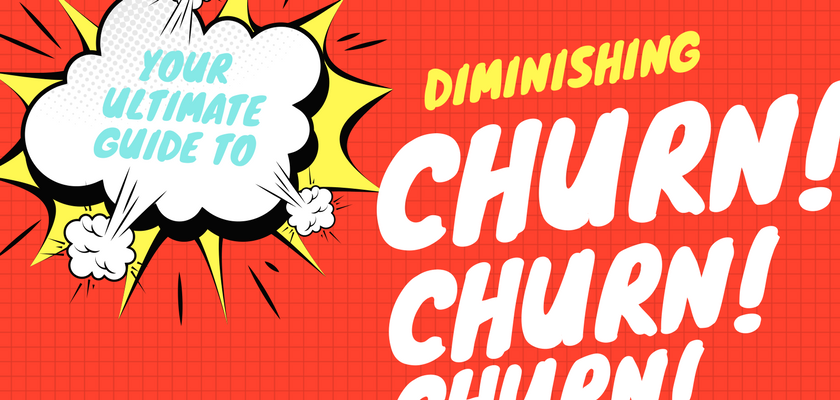— March 13, 2018

In the subscription economy, quickly mitigating and minimizing churn is a critical driver of business success. It’s debatable whether or not a 0% churn rate is possible, but companies can reduce their churn rate down to the optimal level.
If you’ve boarded the Customer Success train, you probably already know why reducing churn is so important. In short, it’s cheaper to retain and grow your existing customers than it is to acquire new ones. Retention is the best way to achieve business success, and guess what the opposite of retention is? Yup, churn can really hurt your company. Here’s how to get started with churn mitigation.
Acquire The Right Customers
This is huge, understanding your audience is numero uno when it comes to churn mitigation. Bad-fit customers are meant to churn, but before they do, they’ll consume your Customer Success team’s time and resources. To make sure you are getting the right customers you should:
- Align your pre-sales teams (Marketing, Sales) with your Customer Success team to define the appropriate buyer persona.
- Highlight the leading benefits and features of your product on your website and throughout the sales process.
- Be transparent about pricing, hidden fees might be a deal-breaker for some customers.
Deliver The Best Onboarding Experience Ever
User-friendly onboarding is the first step to creating loyal, engaged customers. From the get-go, make sure your sign up process is easy, quick, and intuitive. You want to capture that first spark right away and keep it going. Start delivering value from the first interaction: a welcome email should be much more. The welcome email is a great way to get people excited while educating them. Poor onboarding is hard to fix, it takes up a lot more effort and resources, and that journey is more likely to end in churn.
Set Goals With Your New Customers
People don’t buy your product, they buy the outcomes it will deliver, i.e. the solution to the problem they are trying to solve. What is your customer trying to achieve and how can you deliver that value to them within a given time frame? Sometimes, goals are too shy or too extravagant, that’s when Customer Success Managers have to intervene. This can happen through:
- A strong hand-off process between your Sales and your Customer Success teams. What did the customer ask the Sales rep during their first demo? Which part of the product was the deal-maker?
- Customer interviews during onboarding
- Surveys and the drafting of customer personas.
- Executive Business Reviews (formerly called QBRs).
Minimize Time to First Value
A customer buys your product for the value it will deliver. It’s crucial that you deliver and demonstrate value as early as possible. There are many ways to deliver value in early stage onboarding, for instance:
- Tutorials, not on how to use a product, but on how to achieve desired outcomes with it.
- Videos and webinars to make sure they are already learning about different ways to use your product.
- On-screen tips are a great friendly nudge to encourage your users to go deeper into the product.
Gather Customer Intelligence
Don’t fly blind, surprises are no fun in business. Instead, get as much in-depth information about what your customers are doing at each stage of their lifecycle. This allows you to address issues proactively before they become problems and before your customer even thinks about churning.
Understand Your Customers
Don’t just get to know your customers, understand them. What is their thought process? What’s their number 1 priority? How often do they engage with you? How healthy are they? What’s their favorite part of your product? What’s their main pain points? And more importantly, why?
Tier Your User Base
All customers are not created equal. Having different tiers of customers and designing high-touch and low-touch, scalable Customer Success processes is your best bet to ensure business success. If you’re not already familiar with it, make sure to get comfy with the Pareto Principle: 20% of your customers deliver 80% of your revenue. Keep this in mind to ensure your customers get what they pay for, and that your resources are well allocated and focused.
Nudge Customers Into Using Your Features
Customers bought your product, they truly want to be engaged. They want as much insight and guidance as you can give them. If there is anything you can do to help your user achieve a greater ROI, you should be doing it (like, starting (March 15, 2018)). Make sure all of your customers get what they are paying for, or else be ready to wave them goodbye.
Get Personal
Contextual and personalized emails are a great way to create a strong, long-lasting relationship. Make sure your emails always deliver value, you should never just say “hi” – working with your Marketing team is a great way to prepare topical content for every situation. Variables that should trigger proactive and automated engagement include product usage and consumption of key features.
Make Yourself Available
Your customers should know how to reach you. Of course, you can’t just answer their calls all day and spend hours looking at your inbox. An efficient ticketing service, online chat, chat bot, knowledge base, or online community can be great ways to help customers feel close to your business. The bottom line is that they should have an easy, personable, and quick way to get answers when they have a question.
To Conclude
Churn hurts the bottom line, it hurts employee morale, and it hurts company reputation. Making sure your customers are set up for success and on the right track from day 1 is your best bet for improving retention rates.
Business & Finance Articles on Business 2 Community
(62)









